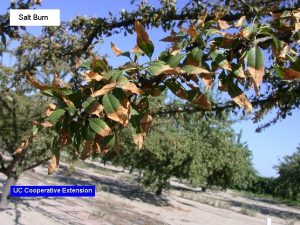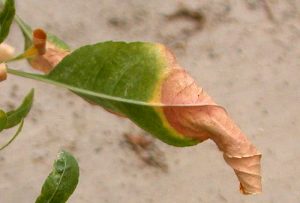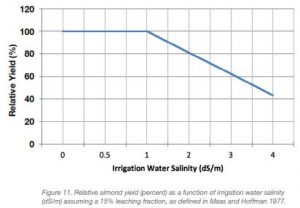Irrigation water contains soluble (dissolved) mineral salts. Overtime, these salts can build-up in the plant root zone. Excess salinity creates osmotic stress. A plant must expend competitive energy to absorb water from a saline soil. In addition to total salt content we are concerned about specific salts such as sodium, chloride, and boron. For the most part, roots normally exclude between 95-99% of the dissolved mineral salts applied. The tree sucks up the water leaving the salt behind. At some point however, the concentration of salts exceeds the tree’s ability to exclude them. The salt is then picked up by the tree, moves to the leaves, and burn occurs. Leaf burn reduces photosynthesis.
Leaf Burn
 … not to be confused with Leaf Scorch, a biological cause
… not to be confused with Leaf Scorch, a biological cause

Water sources are not created equal. For example, our new Well #3 has sweeter water than our Well #2. We have this awareness because we test for water quality annually. The agricultural laboratory with which we contract, scientifically measures the salinity by electrical conductivity (EC) in units of decisiemens per meter (dS/m) Water salinity of up to 1.0 dS/m and average root zone soil salinity 1.5 dS/m is a-okay. [source]
The 2016 lab water analysis report:
- Well #3 Soluble Salts @ 0.53 dS/m
- Well #2 Soluble Salts @ 0.83 dS/m
But, specific salts (Sodium, Chloride, Boron) accordingly are well above optimum range.
There is relief! We cannot easily procure a better water source but we can dissipate the salts from the soil through leaching. Essentially, the soil can hold water moisture up to a point at which time, thanks to gravity, its ability to retain is overcome and water passes through** flushing the salts with it.
Our Sandy Loam soil type has a water holding capacity of .07 to 1.4 inches per foot of soil. Rainfall is nature’s way of cleansing (and it costs very little) but we must assist the leaching process with remedial applied irrigation.
How much is needed? For Well #3, that has irrigation water with electrical conductivity of 0.53 dS/m; the percentage of water that needs to pass beyond the root zone is 7% or 3.9 inches of water. This is in addition to Evapotranspiration* (what the trees ordinarily need to drink). The requirement for Well #2 is double at 14% and nearly 9 inches of extra water. So a takeaway is to favor Well #3. [source]
When? We like to leverage the leaching period with the rainy winter months when trees are dormant and soil fertilization (Nitrogen) has not been applied. This year we had abundant rainfall. The CIMIS estimates 11.45 inches since the first of the year. Whoohoo!
*Evapotranspiration is the loss of water through soil surface evaporation and transpiration through openings in the leaves.
**assumes no barrier e.g. hardpan we rip the soil before planting